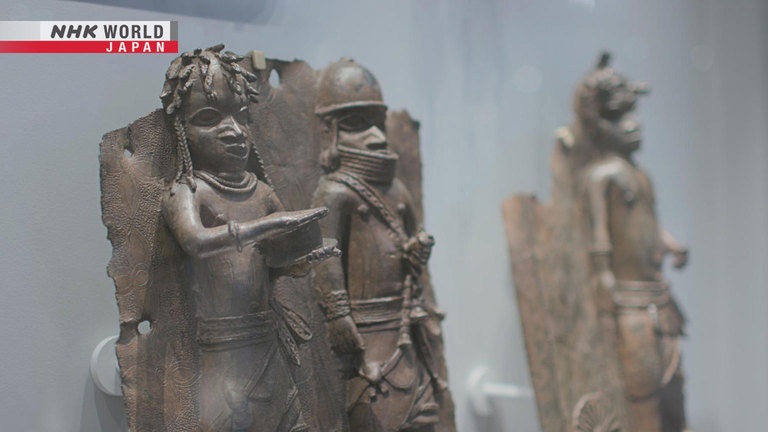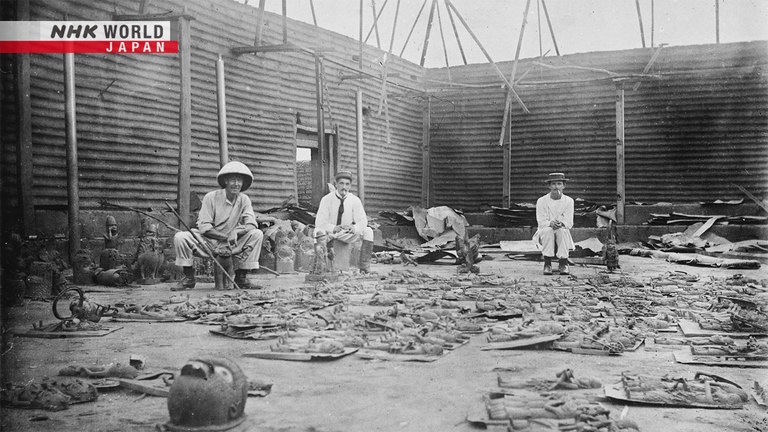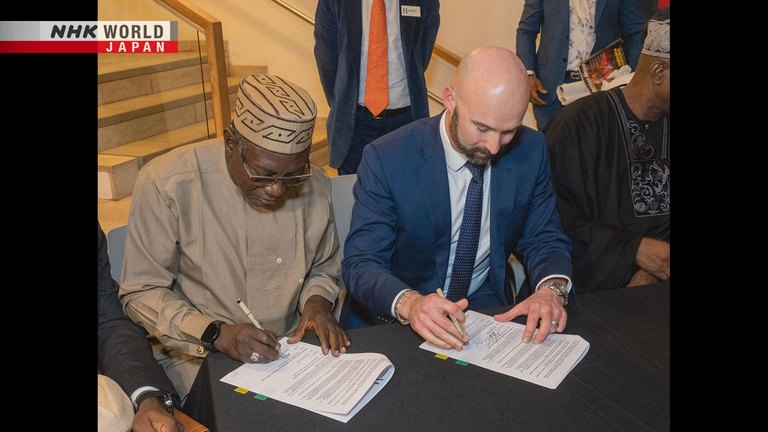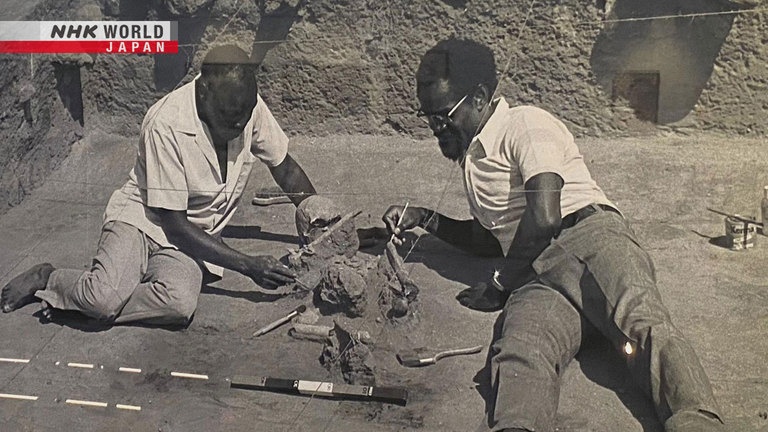Returning the Benin Bronzes: Nick Merriman / Chief Executive of the Horniman Museum
Britain is re-evaluating its past and that battle is playing out in museums across the country. Nick Merriman explains why the Horniman Museum is returning its entire collection of Benin bronzes to Nigeria.




Transcript
Direct Talk
Britain is re-evaluating its past.
Protesters have even toppled a statue
that was seen to celebrate
its colonial history.
Now that battle is playing out
in museums across the country.
The Horniman Museum in London
has artefacts from around the world -
including a number of ancient bronzes.
These were stolen from Benin City,
now part of Nigeria in West Africa,
and once at the heart of the British Empire.
The Horniman has taken
the controversial decision
to return ownership
of the bronzes to Nigeria.
Its Director, Nick Merriman, is determined
that it should tell a more truthful story
about Britain's imperial past.
He believes this will help broaden
its appeal amongst local residents.
Returning the Benin Bronzes
About five or six years ago, we began
really examining what it means
to be a colonial museum.
The Horniman's collection was
founded and collected
during the heyday of the British Empire,
and it continued up to the 1950s
in terms of major acquisitions.
We also realized from
talking to people who didn't visit us
that there were members
of the black community, for example,
who were very suspicious about the Horniman,
seeing it as a colonial museum
and not for them, didn't speak to them,
because things like the Benin bronzes
were not being addressed.
The case for restitution –
the return of objects
to their countries of origin
is gathering pace
and posing a major challenge to museums
across Europe and America.
The Benin Bronzes, like many of the
historic artefacts that fill western museums,
were acquired by military force
and then sold to collectors
like Frederick Horniman,
a wealthy tea merchant,
who founded the museum in 1901.
In February 1897
because of a political and trade dispute
between the British
and the Oba of Benin City,
a military force went in to
essentially punish the Oba for his
what were perceived to be
trade transgressions
and actually attacking some British forces.
And they destroyed and looted
much of the royal palaces and shrines
and took away what seemed
to be some 10,000 objects.
A lot of them, the so-called bronzes,
are actually made of brass
and they're
cast reliefs, each of them unique, depicting
centuries old members
of the Beninese royal family,
political leaders, military chiefs and so on,
which were attached
to the walls of the palace
along with carved elephant ivory tusks,
domestic items,
bracelets and other items
of jewellery and so on.
These objects were then
sold on the market to museums
and private collectors all around the world.
And it seems that
Frederick Horniman was probably
the first collector in Britain
to acquire material
because he bought some directly
from a man who was involved in the looting
just one month after
the looting actually happened in Nigeria.
Although the Nigerian campaign for the
return of the Benin Bronzes began in the 1960s,
it has been given
added impetus in recent years
by the Black Lives Matter protests.
The Horniman is based in south London,
which has many black citizens
who are descended from
former African and Caribbean colonies.
They want to see the museum
confront its colonial legacy.
Certainly when Nigeria
got independence in 1960,
there have been successive calls
for their return
and it's both physically
returning the history,
but also in a way atoning for some of
what were perceived to be
the crimes of the colonial period.
So they have
a sort of historical and
symbolic significance for
Nigerian communities
both in the UK and in Nigeria itself
and locally to us in the Horniman,
actually our largest minority ethnic group
is British Nigerian people.
So they have a
particularly strong stake in this.
And we have had
a permanent display of Benin material,
which has been a sort of source of interest
and contention ever since it was put up.
So restitution is one part of this,
but a much bigger part, I think
is telling actually
just a wider and historically more
complex and nuanced history
of both how the Horniman was founded
and where the money came from
and also where the collections came from.
And actually when we've started to do that,
it's been really welcomed by our visitors.
In November 2022,
the Horniman became the first British museum
to return ownership of a whole collection,
after its trustees gave the go ahead.
Its 72 Benin Bronzes
were officially returned to
Nigeria's National Commission
for Museums and Monuments.
And in a symbolic act,
a few objects were handed back.
The rest remain on loan
and their long-term fate
has not yet been resolved.
We actually returned ownership in November.
And four of the items that were on display
were physically returned.
The rest are on loan.
We see four gaps
with labels explaining that they've been
returned to the Nigerian colleagues.
And throughout the process,
we've been changing the labels to
reflect, first of all, that the claim had
been made and then the outcome of the claim.
The next big thing is to
work over the next 18 months or so
to redisplay the case completely.
And we're doing that
as a sort of co-curation exercise
with colleagues in Nigeria
and with our local British Nigerian community
saying, what do you think
the story should be?
We're not sure whether
all 72 objects will eventually be returned.
Our colleagues in Nigeria, who we've been
working very closely with, they say
they need to build capacity to
take the various, many objects
that are being offered to them
from institutions around the world.
The Horniman is one of Britain's
most popular small museums,
recently named Art Fund Museum of the Year.
It has over 700,000 visitors a year
and is more than a just a museum.
In in addition to its
wide collection of artefacts
it has an aquarium,
a butterfly house
and extensive gardens.
Its future depends on the museum
continuing to change in response
to the needs of the local community.
It's not mainly a tourist destination.
It's a museum that's held in great affection
over generations of visitors
who come again and again
The thing that I find absolutely wonderful
about being in charge of the Horniman is that
we can have long term relationships
with our visitors.
The best museums are always thinking about
the social impact they can make on how to
inspire people,
give people, improve people's
wellbeing and so on.
And if people are just coming
on a once off visit as a tourist,
that's quite difficult to do.
But because people come again and again here,
I often meet people who say
we come every week to the museum,
which is absolutely incredible.
And I meet people who say, well,
I'm a grandparent now.
My grandparents brought me.
the commonest word people say
in relation to the Horniman
when they speak to me
is that I love the Horniman.
So for a museum to evoke love
is a very rare and precious thing.
Nick Merriman became
Director of the Horniman in 2018.
As a PhD student,
he had stressed the need for Britain
to make its museums relevant to everyone.
His passion for collecting
began at an early age.
I was born in Birmingham.
Both my parents left school at 16 to get jobs.
It wasn't therefore
a very academic household.
We didn't really go to museums and galleries,
my father was interested in history,
but he did it through going
and collecting old stuff, old objects,
which he called antiques,
and my mother called junk
that he sort of filled the house with.
When I was 16, I bought a metal detector
and would go and find things
in the local parks and so on.
Then through a teacher
at my secondary school,
I got on an archaeological dig -
a Roman site at weekends -
and the thrill of uncovering
a piece of pottery
that nobody had seen for
2,000 years that really resonated with me.
I'd always been really interested in
not just what the bit of pottery,
finding the bit of pottery,
but what it meant, the bigger picture,
what this tells us about the past.
Nick Merriman's aim at the Horniman
has been to reinvent
and reinterpret the collection,
and to challenge Eurocentric narratives,
which hide the truth about Britain's
violent conquest of Africa.
In its current exhibition,
Ode to the Ancestors,
the museum celebrates
the contribution of Kenyan archaeologists
whose names have not been recorded
in the history books.
When you look at the
academic publications from these sites,
it's British white archaeologists
who author the publications,
but the workforce many of whom were
sort of academically trained were Kenyans.
But their names were not
publicized and not known.
So the ancestors are people
who were nameless, who are now
have now been given names and voices
to rebalance the narrative
around who actually did the work
to unearth this archaeology
and tell more about the history of Kenya.
So, again, it's just a wider
and more accurate story
than the one we would have told otherwise.
The French President Emmanuel Macron,
seen here visiting the country of Benin,
has played a leading role
in arguing for the return
of African artefacts
from museums in Europe and America.
He believes that it is wrong
that so much of Africa's cultural heritage
has been removed from the continent.
Restitution claims are all different.
So there's been a lot of publicity
on the Benin material
because nobody disputes
that they were looted.
But that's one specific case.
I think we're going to see more claims.
We are anticipating some claims
for Australian Aboriginal material
that's called secret and sacred material.
Which is material that should only
have been seen by initiated males.
So I think there's a
cluster of cases that are
looting by force or
inappropriate material in UK museums.
We'll probably see a range of those
being addressed in the years to come.
Those are a tiny proportion
of the holdings in UK museums.
People are often worried about,
oh well, if you give stuff back,
the floodgates will open
and British museums will become empty.
The Horniman has about 300,000 objects
and we've agreed to return ownership
of 72 that were clearly stolen.
The largest collection of Benin bronzes
in Britain is held at the British Museum.
And despite growing media attention,
it has so far refused to return them.
The trustee say that the British Museum Act
prevents them from returning any object
in the collection on moral grounds.
My understanding is that
the British Museum Act
prevents items being
taken out of the collection
unless they're deteriorated beyond repair
or they're dangerous
or they're an exact replica,
an exact duplicate, in other words,
a coin from the same dye.
So even if the trustees wish to return them,
legally they're not allowed to at the moment.
So I think there's an impasse at the moment
which is difficult for
British Museum colleagues to deal with.
So it's essentially a political issue that
could only be resolved by a legal change.
As Merriman looks to the future,
he knows that the Horniman must continue
to challenge its colonial legacy
in order to maintain its appeal
amongst the local community.
His goal is that it should be
a museum for everyone.
I've written on the card
"Museums are for everyone"
because from my PhD, when I was a young man
looking at barriers to museum
visiting to all the jobs I've done,
including the Horniman,
my passion has been about
trying to understand
why some sections of the population
consistently feel that
museums are not for them.
I want to assert that
museums are for everyone.
What we're trying to do at the Horniman
is to realize that in practice.
Museums are for everyone.